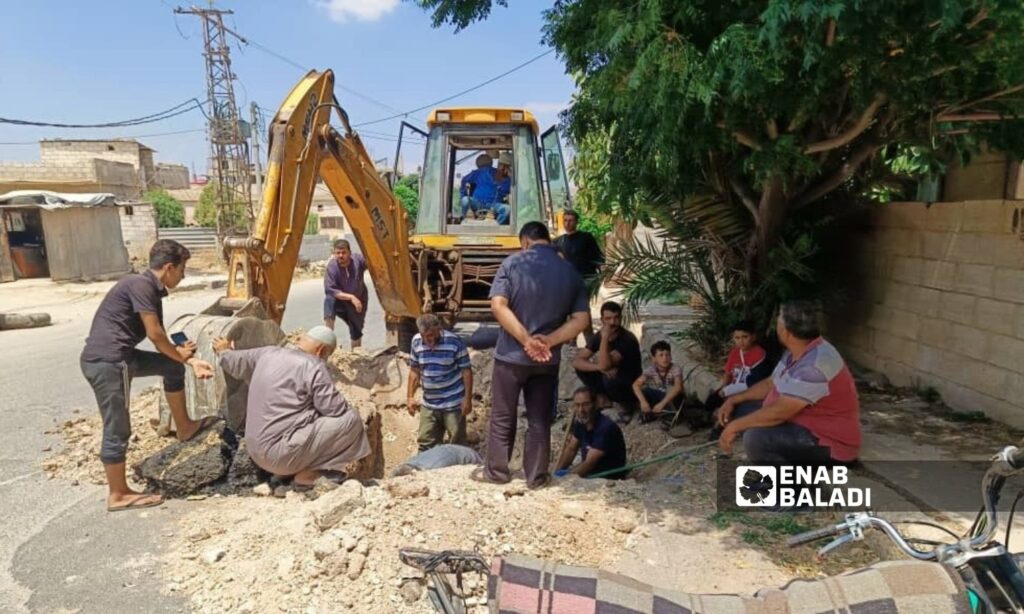Enab Baladi – Halim Muhammad
Despite organizing a campaign to remove the encroachments on the main drinking water line that feeds the city of Daraa al-Balad, al-Sadd Road neighborhood, and the Daraa camp for displaced persons, and a slight improvement in its level, residents still complain of water shortages.
After removing the encroachments, a problem with the quantities of water supplied from the Khirbet Ghazaleh irrigation line emerged, as officials from the Syrian regime’s water institution cite weak electricity and pump failures.
The city of Daraa consists of two parts, the first being Daraa al-Balad, the old part of the city where the Omari Mosque is located, and the second being Daraa al-Mahatta, the newer part of the city that includes public and private institutions and government departments serving Daraa governorate in general.
Residents across the province, southern Syria, suffer from a water crisis accompanied by the drying up of springs and wells, and a weak response from specialized government agencies responsible for solving the crisis.
Community-led campaign with water institution support
In mid-July, a community-led campaign was launched by the local committee in Daraa al-Balad to remove the encroachments, which are violations on the main line used by some residents to obtain strong water flow or for agricultural purposes.
The local committee, endorsed by the Daraa Clan Council that includes representatives from all clans of Daraa al-Balad, is tasked with overseeing public services independently of the municipal council affiliated with the Syrian regime.
A member of the service committee affiliated with the Daraa Clan Council, told Enab Baladi that the campaign removed dozens of encroachments on the main line. He added that the trial period after the removal showed improvement, doubling the amount of water reaching the residents compared to before the removal.
The committee member, who asked to remain anonymous for security reasons, said the water output from the Khirbet Ghazaleh wells is 600 cubic meters per hour, but not all of it goes to Daraa al-Balad. There is a filling point for the drinking water institution’s tankers consuming about 100 cubic meters per hour.
There is also a branch line supplying the displaced persons camp, another for the industrial zone, and a third for the al-Sadd Road neighborhood. The quantities reaching the Daraa al-Balad reservoir are estimated at 300 cubic meters per hour over three days a week.
In a statement to the government al-Thawra newspaper, Mamoun al-Masri, Director of the Drinking Water Institution in Daraa governorate, said that the institution’s teams, in cooperation with the local community, removed 76 encroachments on the main network lines in Daraa al-Balad.
On 16 June, the Daraa Clan Council issued a statement warning residents against encroaching on the drinking water lines under penalty of responsibility, threatening violators with imprisonment, a financial fine, and repairing the damage at their own expense.
Slight improvement
Residents from neighborhoods in Daraa city who spoke to Enab Baladi mentioned that the improvement in water supply was slight and affected some neighborhoods without reaching those far from the main reservoir.
Haitham (35 years old), residing in the al-Sadd Road neighborhood, said that the water shortage crisis is present in all neighborhoods of Daraa city and Daraa al-Balad.
He told Enab Baladi that he still sometimes buys water from mobile tankers, although the al-Sadd Road neighborhood saw a slight improvement in drinking water supply, with the price per cubic meter reaching 28,000 Syrian pounds (about two US dollars).
Yaseen (40 years old) lives on a farm with water available in the western countryside of Daraa, but he is forced to buy water from mobile tankers to fill a five-barrel water tank when he visits his house in Daraa al-Balad.
Yaseen said that the water network was damaged during the years of war, and the main reservoirs that help pressurize water to high areas are out of service.
Electricity is a disruptive factor
After removing the encroachments on the network lines, electricity cuts have emerged as a problem, especially in light of activating the frequency protection system that cuts electricity when loads increase.
Electricity is not supposed to cut off from the water pumping center, as the line is exempt from rationing, but the current frequently cuts off under the pretext of load increases.
A member of the service committee in Daraa al-Balad told Enab Baladi that removing encroachments is part of several problems, adding that the frequent disconnection of the electricity current from the pumping center in Khirbet Ghazaleh is also a reason, along with low water quantities due to pump failure or shutdown.
He continued that officials pass the responsibility between the Water Institution administration and the Electricity Institution administration, ultimately reducing operational hours and lowering the drinking water supply level.
Hani al-Masalmeh, Director of the Electricity Institution in Daraa, attributed the continuous electricity outages to the frequency protection system in a statement to the government al-Thawra newspaper, which cuts off the current when loads increase.
Al-Masalmeh justified the frequency protection system as a means to protect power stations and conversion centers from the damage of excessive loads.
He said that increased consumption by agricultural wells and residents installing electric heaters and air conditioners contributed significantly to electricity consumption, especially given the limited electricity supply to the governorate, which receives 50 megawatts daily, while its actual need is 400 megawatts.
Daraa al-Balad and al-Sadd Road neighborhoods were out of the Syrian regime control at the end of 2012 and were controlled by the opposition factions who managed these areas.
These areas have approximately 50,000 residents, according to a service committee member.
These areas witnessed confrontations between opposition factions and regime forces, leading to infrastructure destruction due to regime forces bombing vital centers, including the main reservoirs, most of which are out of service. The reservoirs help in fair distribution of drinking water, especially in high areas.

